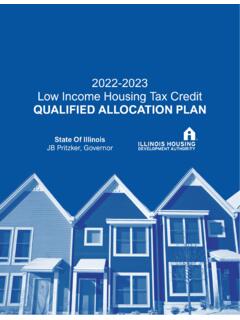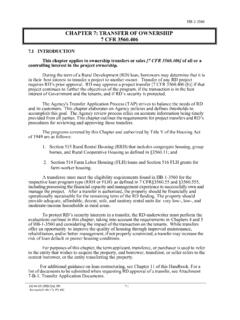Transcription of An Introduction to the Low-Income Housing Tax Credit
1 An Introduction to the Low-Income Housing Tax Credit Updated January 26, 2021. Congressional Research Service RS22389. SUMMARY. RS22389. An Introduction to the Low-Income Housing January 26, 2021. Tax Credit Mark P. Keightley The Low-Income Housing tax Credit ( lihtc ) program is the federal government's primary policy Specialist in Economics tool for encouraging the development and rehabilitation of affordable rental Housing . The program awards developers federal tax credits to offset construction costs in exchange for agreeing to reserve a certain fraction of units that are rent-restricted and for lower- income households.
2 The credits are claimed over a 10-year period. Developers need upfront financing to complete construction so they will usually sell their tax credits to outside investors ( , corporations, financial institutions). in exchange for equity financing. The equity reduces the financing developers would otherwise have to secure and allows tax Credit properties to offer more affordable rents. The lihtc is estimated to cost the government an average of approximately $ billion annually. The 2018 Consolidated Appropriations Act ( 115-141) made two changes to the lihtc program.
3 First, the act increased the amount of credits available to states each year by for years 2018 through 2021. This modification appeared to be in response to concerns over the effects of 115-97, commonly referred to as the Tax Cuts and Jobs Act (TCJA). The changes made by TCJA did not directly alter the lihtc program; however, the act reduced corporate taxes, which had the potential to reduce demand for LIHTCs. Second, the act modified the so-called income test, which determines the maximum income an lihtc tenant may have. Previously, each individual tenant was required to have an income below one of two threshold options (either 50% or 60% of area median gross income [AMI], depending on an election made by the property owner).
4 With the modification, property owners may use a third income test option that allows them to average the income of tenants when determining whether the income restriction is satisfied, but no tenant may have an income in excess of 80% of AMI. To assist certain areas of California that were affected by natural disasters in 2017 and 2018, the Further Consolidated Appropriations Act, 2020 ( 116-94) increased California's 2020 lihtc allocation by the lesser of the state's 2020. lihtc allocations to buildings located in qualified 2017 and 2018 California disaster areas, or 50% of the state's combined 2017 and 2018 total lihtc allocations.
5 Most recently, the Taxpayer Certainty and Disaster Tax Relief Act of 2020, enacted as Division EE of the Consolidated Appropriations Act, 2021 ( 116-260), sets a minimum Credit (or floor ) of 4% for the Housing tax Credit typically used for the rehabilitation of affordable Housing . The Joint Committee on Taxation (JCT) estimates this change will reduce federal revenues by $ billion between FY2021 and FY2030. This change is permanent. Division EE of 116-260 also increased, for calendar years 2021 and 2022, the Credit allocation authority for buildings located in any qualified disaster zone, defined as that portion of any qualified disaster area which was determined by the President during the period beginning on January 1, 2020, and ending on the date which is 60 day from enactment of 116-260.
6 For 2021 the increase is equal to the lesser of $ multiplied by the population residing in a qualified disaster zone, and 65% of the state's overall Credit allocation authority for calendar year 2020. For 2022, the increase is equal to any unused increased Credit allocation authority from 2021 ( , 2021 increased Credit allocation authority may be carried over to 2022). Buildings impacted by this provision will also be granted a one-year extension of the placed in service deadline and the so-called 10% test. The JCT estimates these changes will reduce federal revenues by $887 million between FY2021 and FY2030.
7 There were also a number of bills introduced in the 116th Congress that would have made targeted changes to the lihtc . program. These proposals included 4984, 4865 and S. 767, 4689, 3479 and S. 1956, and 3478. Broader changes to the program were proposed by the Affordable Housing Credit Improvement Act of 2019 ( 3077/S. 1703). Congressional Research Service An Introduction to the Low-Income Housing Tax Credit Contents Overview .. 1. Types of 1. Minimum Credit Rates .. 2. An Example .. 3. The Allocation Process .. 4. Federal Allocation to States .. 4. State Allocation to Developers.
8 4. Developers and Investors .. 5. Recent Legislative Developments .. 6. Contacts Author Information .. 7. Congressional Research Service An Introduction to the Low-Income Housing Tax Credit Overview The Low-Income Housing tax Credit ( lihtc ) program, which was created by the Tax Reform Act of 1986 ( 99-514), is the federal government's primary policy tool for the development of affordable rental Housing . LIHTCs are awarded to developers to offset the cost of constructing rental Housing in exchange for agreeing to reserve a fraction of rent-restricted units for lower- income households.
9 Though a federal tax incentive, the program is primarily administered by state Housing finance agencies (HFAs) that award tax credits to developers. Developers may claim the tax credits in equal amounts over 10 years once a property is placed in service, which means it is completed and available to be rented. Due to the need for upfront financing to complete construction, developers typically sell the 10-year stream of tax credits to outside investors ( , corporations, financial institutions) in exchange for equity financing. The equity that is raised reduces the amount of debt and other funding that would otherwise be required.
10 With lower financing costs, it becomes financially feasible for tax Credit properties to charge lower rents, and thus, potentially expand the supply of affordable rental Housing . The lihtc . program is estimated to cost the government an average of $ billion annually. 1. Types of Credits There are two types of LIHTCs available to developers. The so-called 9% Credit is generally reserved for new construction and is intended to deliver up to a 70% subsidy. The so-called 4%. Credit is typically used for rehabilitation projects utilizing at least 50% in federally tax-exempt bond financing and is designed to deliver up to a 30% subsidy.















